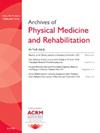多成分运动干预对中风幸存者行走能力恢复的影响:带 Meta 分析的系统综述。
IF 3.6
2区 医学
Q1 REHABILITATION
Archives of physical medicine and rehabilitation
Pub Date : 2025-01-01
DOI:10.1016/j.apmr.2024.06.023
引用次数: 0
摘要
目的评估多组分运动(MCE)在改善中风患者行走能力方面是否比单一运动更有效:数据来源:系统综述和荟萃分析:数据来源:对 PubMed、Embase、Web of Science、Cochrane Library 和 CINAHL 进行了系统检索,检索时间为各数据库建立后至 2024 年 2 月。研究选择:研究选择:纳入了对中风幸存者进行多组分运动治疗的随机对照试验。对照组接受常规治疗,如常规治疗或无干预或假训练;实验组接受多组分运动。结果测量指标为行走耐力、步态速度和平衡能力:数据提取表由两名独立审稿人完成,使用Cochrane随机对照试验偏倚风险工具评估偏倚风险,使用Review Manager 5.4软件进行数据分析,使用亚组分析和敏感性分析对异质性较高的结果进行补充,遵循2020年系统综述和元分析首选报告项目指南。数据综合:共纳入12项研究。Meta分析发现,与对照组相比,MCE对步速有显著影响(MD = 0.11; 95%CI 0.06, 0.16, I2 = 0%),但对平衡能力的影响无统计学意义。这些结果表明,多组分运动可提高脑卒中患者的行走耐力和行走速度:结论:多组分运动有助于改善脑卒中幸存者的步速。结论:多组分运动有助于改善脑卒中幸存者的步态速度,延长多组分运动时间可能对改善脑卒中患者的行走耐力有更好的效果。本文章由计算机程序翻译,如有差异,请以英文原文为准。
Effect of a Multicomponent Exercise Intervention on Recovery of Walking Ability in Stroke Survivors: A Systematic Review With Meta-analysis
Objective
To evaluate whether multicomponent exercise (MCE) is more effective than single exercise in improving walking ability in patients with stroke.
Design
A systematic review and meta-analysis.
Data Sources
A systematic search of PubMed, Embase, Web of Science, Cochrane Library, and CINAHL from the establishment of each database to February 2024 was performed. A combination of medical subject headings and free-text terms relating to stroke and exercise were searched.
Study Selection
Randomized controlled trials treating stroke survivors with MCE were included. The control groups received conventional treatments such as conventional treatment or no intervention or sham training; the experimental groups received MCE. The outcome measures were walking endurance, gait speed, and balance ability.
Data Extraction
The data extraction form was completed by 2 independent reviewers. The risk of bias was assessed using the Cochrane Risk of Bias Tool for randomized controlled trials. Review manager 5.4 software was used for data analysis. Subgroup analysis and sensitivity analysis were used to supplement the results with higher heterogeneity. The preferred reporting project for systematic reviews and meta-analyses 2020 guidelines were followed.
Data Synthesis
Twelve studies were included. Meta-analyses found that compared with the control group, the MCE significantly affected gait speed (mean difference=0.11; 95% CI, 0.06-0.16; I2=0%), but the effect on balance ability was not statistically significant. Subgroup analysis showed that MCE (≥60min) was effective in improving walking endurance. These results suggest that MCE improves walking endurance and walking speed in patients with stroke.
Conclusions
MCE helps improve the gait speed of stroke survivors. Prolonging the MCE time may have a better effect on improving the walking endurance of patients with stroke.
求助全文
通过发布文献求助,成功后即可免费获取论文全文。
去求助
来源期刊
CiteScore
6.20
自引率
4.70%
发文量
495
审稿时长
38 days
期刊介绍:
The Archives of Physical Medicine and Rehabilitation publishes original, peer-reviewed research and clinical reports on important trends and developments in physical medicine and rehabilitation and related fields. This international journal brings researchers and clinicians authoritative information on the therapeutic utilization of physical, behavioral and pharmaceutical agents in providing comprehensive care for individuals with chronic illness and disabilities.
Archives began publication in 1920, publishes monthly, and is the official journal of the American Congress of Rehabilitation Medicine. Its papers are cited more often than any other rehabilitation journal.

 求助内容:
求助内容: 应助结果提醒方式:
应助结果提醒方式:


